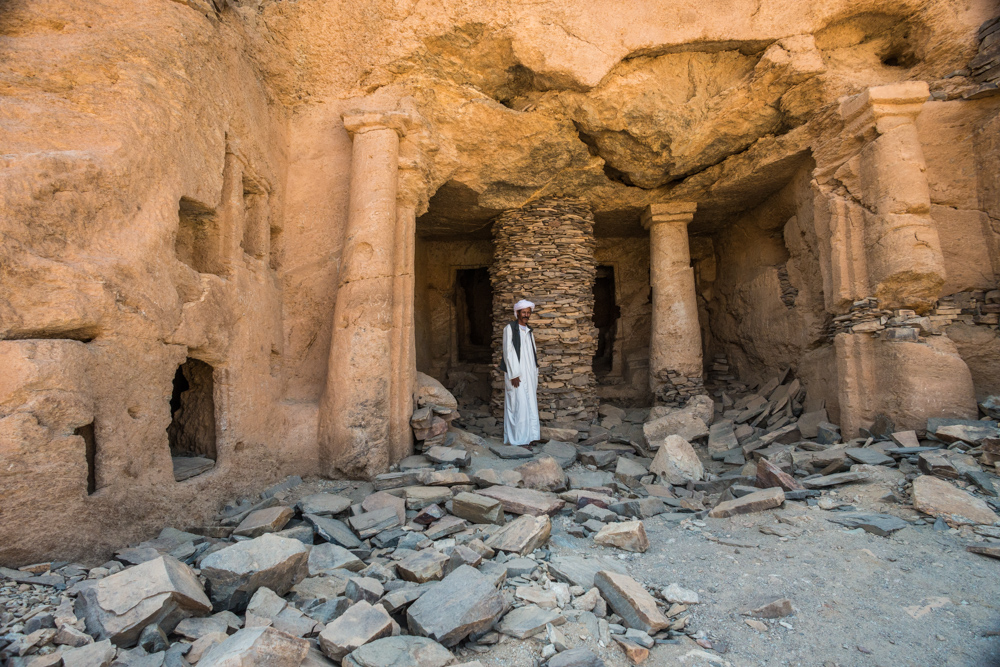There are very few available sources on the origins of Ababda. All western sources agree that the Ababda are a major subdivision of the Beja people, who are an ancient Cushitic people. The Beja have dwelt in the Nubian Desert across Egypt, Sudan, and parts of Ethiopia since times immemorial, and are closely related to the ancient Egyptians. This is manifested by their distinct resemblance to surviving depictions of predynastic Egyptian.

By: Gianni Bodini
However, regional and local sources trace the lineage of current Ababda to the Arabian Peninsula. They cite El-Zobeir Ibn El-Awwam, Prophet Mohammed’s cousin, as an ancestor to the people who spread to the Eastern Desert and settled between the Nile Valley and Red Sea south of Quseir, and from whom current Ababda descend.
This distinction sets the Ababda apart from the Bishari, the major Beja subgroup in the south of the Egyptian Nubian Desert. The distinction is both ethnic and cultural. The Ababda are more predominantly Arab Semite than Cushitic, they speak Arabic, although they have retained elements of the Beja language and customs to an extent, and they are Sunni Muslim. This is opposed to the Bishari, their southern neighbors, whose features are more pronouncedly Cushitic, are bilingual in Beja and Arabic, and are Sufi Muslim. A nomadic pastoral people, the culture of the Ababda has always been shaped by the environment and nature of the Eastern Desert and Wadi El-Gemal. Since the beginning of time, they have grazed their camels and cattle in the more fertile valleys, and also relied on fishing from the sea.

By: Samah Abaza

By: Gianni Bodini
The desertification of the area inhabited by the Ababda began some 5,000 years ago. Before that rivers flowed through it, and it was vegetated by forests and inhabited by animals such as elephants, rhinos, and giraffes. Archaeological evidence shows a continuity of the way of life of its neolithic inhabitants all the way to the peoples who dwelt there during the time of Arab rule. In antiquity, Ababda got in contact and found work with the Ancient Egyptians, Greeks, and Romans, who were drawn to their area to quarry the mineral-rich mines. As far back as 1300 B.C., Ancient Egyptians mined the Eastern Desert for precious metal and stones, most prominently gold and emerald.

In 275 B.C., Ptolemy II, founded the port city of Berenice to import elephants from Africa to use in wars. The city developed into a large trade centre in the Roman period. And many roads were constructed to connect Berenice to Nile Valley cities as far north as current-day Ashmun (to the ancient city of Antinopolis, founded by Hadrian in 130 A.D.). Never conquered or assimilated into the Nile Valley civilizations, and ever the desert dwelling people, the Ababda often served as miners and guards for excavation operations, and as trackers and guides to the trade caravan routes in the area. Remnants of these activities bear witness to that period to this day. Most famously the Sukait Temple, Roman emerald mines and their facilities, as well as parts of the ancient Roman roads.

By: Manfred Bortoli
In the 15th century, they were absorbed into Islam by intermarriage and trade relations with incoming Muslim Arab tribes. During this period, the Ababda most prominently convoyed pilgrims from the Nile Valley to the port of Aidhab – an ancient port located in current-day Halayeb, and from which pilgrims would embark to Jeddah on their way to Mecca.
